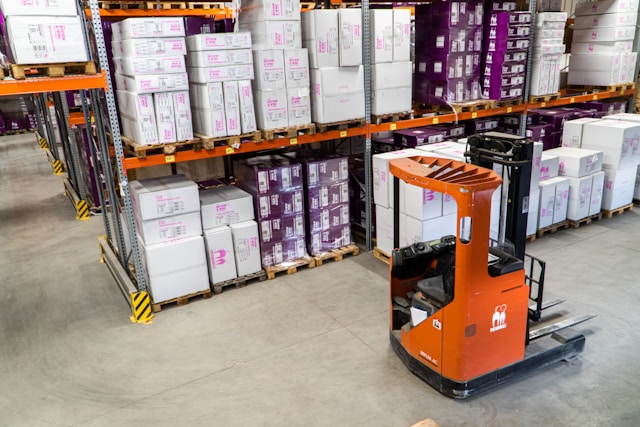In the world of managing warehouses, making sure things run smoothly and quickly is super important. With more and more people wanting their orders fast, it’s crucial for warehouse managers to know how well their operations are working.
But how do they figure that out? What are the best ways to measure how productive a warehouse is? Let’s find out some good ways to do it and make things even better.
Before we go further into this topic, don’t forget to follow my LinkedIn account. You’ll get more helpful insights on supply chain management there.
Table of Contents
Methods for Measuring Warehouse Operations Productivity
Throughput Rate
Measuring throughput rate is super important for warehouse managers. It’s basically about keeping track of how quickly stuff moves through the warehouse in a set time, like per hour or per day.
By counting how many items get processed during that time, managers can see how well their warehouse is running. This helps them figure out if things are flowing smoothly or if there are any areas that need fixing.
Understanding throughput rate is key for managers to use their resources wisely and make sure everything runs smoothly. A high throughput rate means things are moving fast, which is great for getting orders out quickly.
But if the rate is low, it could mean there are problems like bottlenecks or not enough space. By keeping an eye on throughput rates and comparing them to standards, managers can find where things aren’t working well and make changes to improve.
By looking at throughput rate over time, managers can spot trends and make smart decisions to keep things running smoothly. This might mean adjusting how many people are working, changing the layout of the warehouse, or improving processes.
Basically, using data from throughput rate helps managers make their warehouse work better, leading to happier customers and a more efficient operation overall.
Order Picking Accuracy
Making sure customer orders are accurate is super important for warehouses and keeping customers happy. We measure this by looking at how many orders are filled correctly out of all the orders processed in a certain time.
This helps us see how well the warehouse is doing its job and paying attention to details. When orders are filled accurately, it shows that the warehouse is doing a great job, which is key for keeping customers happy and satisfied.

Getting orders right not only helps the warehouse run smoothly but also makes customers happy. When orders are wrong, it can cause delays and upset customers, which isn’t good for the warehouse’s reputation.
But when orders are accurate, it builds trust with customers and keeps them coming back. So, measuring order accuracy isn’t just about checking how well the warehouse is doing; it’s also about making sure customers are happy and loyal.
By looking at the data on order accuracy, warehouse managers can find ways to make things even better. They can figure out what’s causing mistakes, like not enough training or problems with technology, and fix them.
This might mean using barcode scanners, changing how things are organized, or giving more training to staff. By finding and fixing mistakes early, warehouses can improve their operations, save money, and make sure customers keep coming back for more.
Inventory Turnover Ratio
Inventory turnover ratio is a really important measure for how well a warehouse manages its stuff. It’s like checking how often items get sold or replaced within a certain time, usually every year or every few months.
When the turnover ratio is high, it means things are moving fast through the warehouse. This shows that the warehouse is doing a great job managing its inventory and using its space well, which saves money and resources.
Having a high inventory turnover ratio shows that the warehouse is good at predicting what customers want. This means they’re not keeping too much stuff in stock that might go bad or become outdated.
Plus, it means orders are getting filled quickly, which keeps customers happy and helps the warehouse stay competitive. It’s like a win-win situation for everyone involved!
Having a high inventory turnover ratio also means more money is coming in faster. By not keeping stuff sitting around for too long, the warehouse can use that money to invest in other things or grow the business.
This helps the warehouse stay financially healthy and keeps things running smoothly. So, by keeping an eye on inventory turnover ratio, warehouses can make sure they’re using their resources wisely and staying ahead of the game.
You might also like:
- 6 Tips to Manage Inventory with Expiry Dates and Minimize Losses
- 7 Ways to Manage Material Specification Changes in the Warehouse to Ensure Smooth Transitions
Labor Productivity
Analyzing how well warehouse staff work is super important for making the warehouse run better. Managers keep a close eye on pickers, packers, and forklift operators to see where they can do better.
They check things like how many items they pick in an hour, how accurately they pack orders, and how well they use equipment. This helps managers figure out who’s doing great and who needs a little extra help.

By looking at staff productivity, managers can make the warehouse work more efficiently and save money. They find where things are slowing down or not working well in the order process and make changes to fix it.
This might mean changing how people do their jobs, making new routes for picking items, or using machines to do tasks faster. By making these improvements, warehouses can work better and spend less money on labor.
Looking at staff productivity also helps make the warehouse a better place to work. Managers set goals for staff and check how well they’re doing regularly.
By giving feedback and recognizing good work, staff feel proud of what they do and work even harder. This makes the whole team happier and more motivated to do their best, which helps the warehouse run smoothly and be successful.
Space Utilization
Checking how well warehouse space is used is really important for making sure everything runs smoothly. Warehouse managers compare how much space is actually used with how much space is available.
This helps them see if the warehouse is being used efficiently. By looking at things like aisle width, shelf height, and how densely things are stored, managers can find ways to use space better and save room.
Understanding how warehouse space is used helps managers find ways to store things more efficiently and make work easier.
For example, if some areas aren’t used well, managers can change how shelves are arranged, use taller shelves, or bring in machines to help store and get items faster. By making these changes, warehouses can use space smarter and make work faster and easier for everyone.
Checking warehouse space use is also important for planning ahead. By thinking about how much stuff they’ll have in the future, managers can make sure the warehouse is ready for it.
This means they can avoid running out of space or needing to expand suddenly, which can cost a lot of money. By keeping an eye on space use and making changes as needed, warehouses can stay flexible and ready for whatever comes their way.
Determining the Most Appropriate Method
Picking the right way to measure how well a warehouse works depends on a few things, like what kind of business it is, what kind of stuff it handles, and what goals it has. Here’s how to figure out which method is best.
Identify Key Performance Indicators (KPIs)
Choosing which parts of warehouse work are most important for reaching goals is a big first step in making things work better. Key Performance Indicators (KPIs) are like guides helping managers see if the warehouse is heading in the right direction.
For example, “throughput” measures how much stuff moves through the warehouse in a certain time. It shows if the warehouse is keeping up with customer orders, making them happy.

Another important KPI is “accuracy,” which checks if orders are filled correctly. Getting orders right is super important for keeping customers happy and trusting the warehouse.
Lastly, “labor efficiency” looks at how well workers do their jobs. By measuring things like how many items they pick in an hour, managers can see if the warehouse is working efficiently and saving money.
By keeping an eye on these important KPIs, managers can make sure the warehouse is doing what it needs to do to reach its goals. This helps keep customers happy, saves money, and makes the warehouse run smoothly.
Consider Industry Best Practices
Researching industry benchmarks and best practices is really important for making warehouses work better. It’s like looking at what other warehouses are doing well and learning from them.
By checking out what standards and practices are common in the industry, managers can see how their warehouse compares and find ways to improve. This involves looking at things like how fast things move through the warehouse, how often orders are filled correctly, and how efficiently workers do their jobs.
Learning from industry best practices helps managers find new ways to make the warehouse more productive and efficient. They can see what’s worked for other warehouses and try it out themselves.
This might mean using new technology, like special software or machines, to make things easier. Or it could involve organizing the warehouse layout in a smarter way to save time and space. By borrowing ideas from others, warehouses can stay up-to-date and keep getting better.
Checking industry benchmarks and best practices also keeps warehouses moving forward. By staying on top of what’s new in the industry, managers can adapt to changes and keep customers happy.
This helps warehouses stay competitive and deliver the best service possible. So, by learning from others and staying informed, warehouses can keep improving and be successful in the long run.
You might also like:
- 4 Criteria for Suitable Containers to Ensure Food Safety in Shipping
- How to Create Standard Container Vanning Layouts
Evaluate Technological Solutions
Using technology like Warehouse Management Systems (WMS) and data analytics tools can make warehouses work better. WMS platforms have lots of features to help manage things like inventory, orders, and workers.
By using a WMS, warehouses can automate tasks like tracking inventory and routing orders, which helps reduce mistakes and makes things run smoother. Plus, WMS platforms give managers real-time updates on what’s happening in the warehouse, so they can make quick decisions based on the data.

Data analytics tools are also really helpful for making warehouses more efficient. They let managers dig into all the data the warehouse collects to find useful insights.
By looking at things like trends and patterns, warehouses can find ways to work better and save money. Fancy techniques like predictive modeling can even help forecast demand and make sure the warehouse has the right amount of stuff on hand.
By using technology, warehouses can make sure everyone is on the same page and working together smoothly. WMS and data analytics tools help share information and make communication easier between different parts of the warehouse. This helps managers make smart decisions fast, so the warehouse can run at its best.
Overall, using technology helps warehouses stay competitive and successful in the fast-paced world of logistics.
Align with Organizational Goals
Choosing the right ways to measure how well a warehouse works is super important for making sure the whole organization succeeds.
For example, if the main goal is to make customers happy, then things like order accuracy, delivery times, and customer satisfaction scores are the most important. By focusing on these things, warehouse managers can make sure processes are optimized to give customers a great experience, which keeps them coming back.
If the goal is to save money, then measuring things like how efficiently workers do their jobs, how quickly inventory moves, and how well space is used becomes really important.
By keeping an eye on these metrics, managers can find where things aren’t working well and fix them. This helps the warehouse run smoother and saves money, which is great for the whole organization.
And if the goal is to manage inventory better, then metrics like inventory accuracy and turnover rates are key. By focusing on these areas, managers can make sure there’s enough stock on hand without wasting money on extra inventory.
This helps the warehouse stay profitable and competitive in the market. So, by picking measurement methods that match broader business goals, warehouse managers can make sure their efforts are making a real difference in the success of the organization.
Frequency of Measurement
How often we check how well the warehouse is working is really important for keeping things running smoothly. The best timing for these checks can vary depending on how fast things are moving in the warehouse, if it’s a busy or slow time of year, and what the big goals are.
Regular checks, like every week or month, give managers quick updates on how things are going and help catch any problems early. This lets them fix things fast and keep everything running smoothly.

But sometimes, it’s good to take a closer look at how the warehouse is doing. Quarterly or yearly reviews give managers a bigger picture of how things are going over time.
This helps them see if the warehouse is getting closer to its big goals and find areas where things could be better. By doing these deeper dives into how productive the warehouse is, managers can make smarter decisions and keep improving over time.
The timing of these checks should match how fast things are changing in the warehouse and the wider industry. In fast-moving industries, more frequent checks might be needed to keep up with changes.
But in slower industries, less frequent checks might be okay, with more focus on long-term planning. The key is finding the right balance between quick updates for fixing problems now and bigger reviews for planning ahead and getting better over time.
Conclusion
To sum up, keeping track of how well a warehouse works is really important and involves looking at lots of different things.
By using the right methods and checking regularly, managers can find ways to make things better, use resources smarter, and make the warehouse run smoother overall.
So, by measuring productivity and keeping an eye on what’s happening, warehouses can keep improving and be more efficient in the long run.
I hope you find it helpful!
Please share this article with your colleagues so they can also benefit. For more insights on supply chain management, follow my LinkedIn account. You’re free to use all articles on this blog for any purpose, even for commercial use, without needing to give credit.

 by
by 

